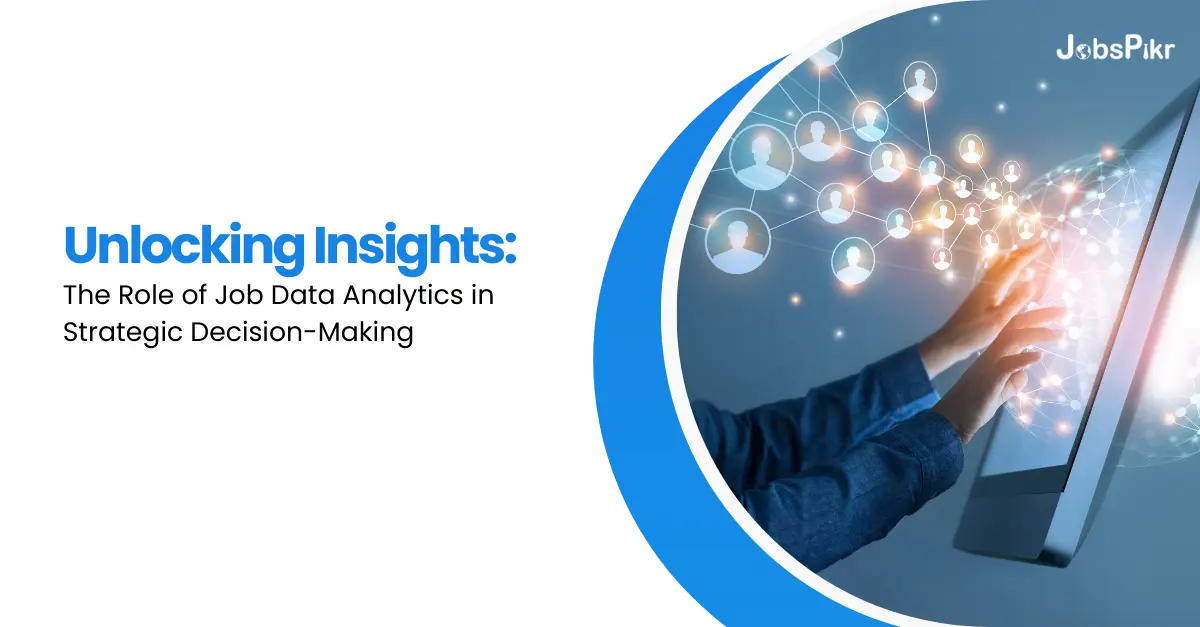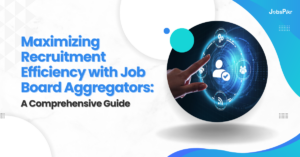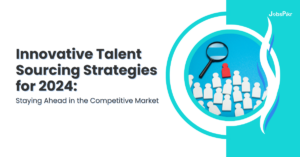Introduction to Job Data Analytics
Data analytics in the realm of job data signifies a groundbreaking field merging data science with human resource management. Organizations glean crucial understandings of workforce behaviors by meticulously analyzing data pertinent to employment. This analytical methodology assists in enhancing recruitment strategies, identifying skill deficiencies, and projecting future hiring needs. Harnessing insights derived from analytics guides decision-makers in fostering data-centric cultures, guaranteeing that HR strategies are grounded in evidence rather than intuition. With the proliferation of job-related data, a wealth of opportunities arise for pioneering practices in constructing enduring, streamlined, and competitive organizations.
The Importance of Data-Driven Decision-Making in Recruitment
The talent acquisition landscape, data-driven decision-making is a critical differentiator. By leveraging job data analytics, recruiters can uncover patterns and insights that inform smarter hiring strategies. This approach allows for:
- Optimization of the Recruitment Process: By analyzing trends and outcomes, organizations can refine job postings, selection criteria, and interview techniques to attract high-quality candidates.
- Reduction of Bias: Objective data enables a fair assessment of candidates, diminishing unconscious biases that might pervade human decision-making.
- Enhanced Candidate Experience: Data analytics can help tailor the recruitment process, improving engagement and conveying an employer’s dedication to innovation and inclusivity.
- Predictive Analysis: Utilizing historical data can predict future hiring needs and inform the development of proactive talent pools.
Embracing data-driven recruitment ultimately leads to robust decision-making, driving organizational success through the acquisition of the right talent.
Key Sources of Job Data and Their Integration into Analysis Tools
- Government Labor Statistics: Entities such as the U.S. Bureau of Labor Statistics furnish extensive data on employment patterns, salaries, and productivity, which can be incorporated into analytical platforms to derive high-level insights.
- Industry-Specific Databases: Niche job databases provide detailed information tailored to specific sectors, empowering businesses to compare themselves with competitors.
- Surveys and Research Studies: Resources like the Occupational Information Network (O*NET) deliver both qualitative and quantitative job-related data, enriching analytical models with intricate nuances.
- Internal Company Data: Information regarding recruitment, staff retention, performance metrics, and employee satisfaction is utilized to anticipate trends and facilitate workforce planning.
- Social Media and Job Platforms: Aggregating job listing information and candidate profiles from platforms like LinkedIn yields real-time labor market intelligence.
- HR Software and Information Systems: Integration of systems like Applicant Tracking Systems (ATS) and Human Resource Information Systems (HRIS) enables seamless data flow into analytics tools.
Understanding the Job Market Through Trend Analysis
Job data analytics is essential for deciphering the complexities of the job market through trend analysis. By examining historical data, employment sector shifts, and emerging industry needs, businesses discern patterns that forecast future labor demands. With robust analytical tools, employers:
- Identify growth industries and roles
- Recognize declining sectors
- Adapt to technological advancements affecting job roles
- Assess supply and demand dynamics for specific skill sets
- Develop strategic workforce plans aligned with market trends
This foresight enables organizations to remain competitive and agile in an ever-changing economic landscape.
How to Use Job Data Analytics to Identify Skills Gaps
Organizations can harness job data analytics to pinpoint skills gaps within their workforce. Below are steps to effectively identify these gaps:
- Collect Data: Aggregate job-related data from various sources, including job descriptions, performance reviews, and industry trends.
- Analyze Requirements: Utilize analytics tools to dissect the data and identify the key skills and qualifications required for each role.
- Assess Current Capabilities: Compare the desired skills with the current skills of employees, assessing the level of proficiency in each area.
- Identify Discrepancies: Highlight the areas where there are significant differences between the current state and the ideal skill sets.
- Prioritize Gaps: Determine which skills gaps are most critical to address based on their impact on organizational objectives and strategic goals.
- Implement Learning Initiatives: Develop targeted training and development programs to address the crucial skills deficits identified by the analysis.
By systematically working through these steps, organizations can strategically close skills gaps and enhance overall performance.
Optimizing Job Descriptions and Listings with Data Insights
Human Resources professionals are increasingly turning to data analytics to enhance job descriptions and listings. By leveraging historical data, patterns indicating successful hires inform keyword optimization, ensuring job postings resonate with the right candidates. Analyzing applicant flow data helps understand which platforms yield the highest quality applicants. A/B testing different versions of job descriptions can reveal elements that capture attention and prompt desired actions. A sentiment analysis of employee feedback can also help employers craft job postings that better reflect their company culture and values, attracting candidates who will thrive there.
Improving Hiring Efficiency and Quality with Predictive Analytics
Organizations are increasingly leveraging predictive analytics in hiring to enhance decision-making, reduce costs, and boost performance. By analyzing historical data, predictive models identify patterns that relate to successful hires. This informs recruitment strategies by:
- Targeting Ideal Candidates: Analytics pinpoint traits of high performers, enabling better candidate targeting.
- Enhancing Cultural Fit: Predictive models assess the likelihood of a candidate fitting within a company’s culture.
- Predicting Turnover: Analytics help forecast candidate tenure, reducing turnover rates.
- Streamlining Recruitment: By prioritizing promising candidates, companies expedite the recruitment process.
Through these methods, predictive analytics significantly strengthen hiring practices.
Aligning Workforce Planning with Business Strategy Using Job Data
Organizations seeking competitive advantage must align workforce planning with overarching business strategies. By leveraging job data analytics, companies discern skills shortages and talent surpluses, tailoring recruitment and development accordingly. This strategic alignment facilitates:
- Proactive talent acquisition, securing necessary competencies for future business endeavors
- Identification of roles critical for business growth, focusing retention efforts to mitigate risks
- Data-driven succession planning, ensuring continuity in key positions
- Optimization of labor costs by aligning staff competencies with strategic initiatives
Ultimately, informed workforce planning enables organizations to remain agile and focused on long-term objectives.
Tackling Diversity and Inclusion Objectives with Data Analysis
Image Source: AIHR
Data analytics is pivotal in advancing diversity and inclusion (D&I) within the workplace. By examining workforce data, organizations can identify imbalances and develop strategies for improvement. Key metrics include demographic diversity, pay equity, and promotion rates. Data can illuminate unconscious biases in hiring or management, prompting targeted training programs. Additionally, examining retention and turnover rates among diverse groups can guide policies that foster an inclusive culture. With empirical analysis, companies can set measurable D&I goals, track progress, and hold leadership accountable, thus integrating D&I into their strategic framework.
Enhancing Employee Retention Through Analytics-Driven Initiatives
Businesses utilizing job data analytics acquire valuable insights into employee behavior, preferences, and areas of concern. Through the implementation of machine learning algorithms and predictive modeling, organizations can identify the drivers behind elevated turnover rates, including factors such as limited career advancement opportunities, discontent with management, or insufficient compensation. Equipped with this information, companies can:
- Create targeted retention programs addressing key concerns.
- Personalize employee development plans to increase engagement.
- Adjust compensation strategies to align with market standards.
Employing analytics-driven initiatives empowers employers to predict and address turnover risks proactively, cultivating a workforce that is more stable and content.
Assessing the Impact of HR Interventions through Data Analytics
Human Resources (HR) interventions are designed to enhance organizational performance and employee well-being. Data analytics plays a crucial role in augmenting these efforts by facilitating precise evaluation of outcomes. By utilizing key metrics such as employee retention rates, satisfaction scores, and performance indicators, organizations can measure the effectiveness of HR initiatives accurately. This data-driven approach enables:
- Rigorous analysis of current HR strategies to pinpoint strengths and weaknesses
- Identification of patterns and trends to inform future interventions
- Data-driven decision-making to tailor HR programs to specific organizational needs
By leveraging analytics, HR professionals can substantiate the impact of their interventions, fostering a culture of continuous improvement and strategic alignment.
Future Trends in Job Data Analytics and its Role in Strategic Planning
The trajectory of job data analytics is gearing towards even more advanced predictive models. Companies will increasingly integrate artificial intelligence and machine learning to analyze job trends, performance metrics, and skill requirements. This will offer:
- Enhanced forecasting of workforce needs
- Precision in talent acquisition strategies
- More informed succession planning processes
As strategic planning becomes more data-driven, the role of job data analytics will evolve into a proactive tool. It will be indispensable for crafting real-time, adaptive strategies that align human capital with emerging business opportunities and challenges.
Conclusion: Transforming HR into a Strategic Partner with Job Data Analytics
In today’s fast-paced and highly competitive environment, embracing job data analytics emerges as a game-changer in reshaping HR from a conventional support role to a strategic ally. Through the integration of thorough job data analytics:
- HR teams can better pinpoint and prepare for talent requirements.
- They can devise strategies backed by data to make the most of the workforce.
- Employee engagement and productivity can be boosted significantly.
- The organization can ensure its talent pool aligns seamlessly with its long-term objectives.
FAQ
How Can Job Data Analytics Aid in Predicting and Preparing for Industry Disruptions?
1. Recognizing Predictive Analytics in Trends in the Employment Market and Industry Upheavals
By combining data science and human resource management, predictive analytics gives businesses insights into the behaviors of their employees. Businesses can estimate future recruiting needs, identify talent shortages, and improve recruitment efforts by carefully examining employment-related data. By ensuring that HR policies are supported by facts, this data-driven strategy promotes data-centric cultures inside businesses.
2. Using Analytics of Job Data to Predict Changes in the Industry
Analytics for job data is essential for facilitating data-driven hiring decisions. Organizations may improve candidate experience, lessen bias in candidate evaluation, streamline the hiring process, and do predictive research to foresee future hiring requirements by utilizing analytics technologies. Businesses may make better hiring decisions, adjust to shifting market conditions, and ultimately achieve organizational success through the acquisition of the right personnel by leveraging insights from job data analytics.
3. Harnessing JobsPikr for Predictive Insights
With JobsPikr, businesses can obtain a comprehensive platform for accessing real-time job data and advanced data analysis tools, enabling them to make strategic decisions with predictive insights. Through the utilization of JobsPikr’s vast job posting database and advanced analytics functionalities, enterprises may effectively follow sector-specific patterns, observe competitor movements, and forecast future labor market conditions. Using JobsPikr’s tools, firms can proactively plan their workforce strategy and remain ahead of the competition by identifying emerging job roles, skill requirements, and industry disruptors.
In conclusion, firms can effectively predict and get ready for market disruptions by utilizing job data analytics, which includes technologies such as JobsPikr. Organizations may position themselves for success in a changing business environment, adjust to shifting market conditions, and make well-informed decisions by utilizing predictive analytics skills.




